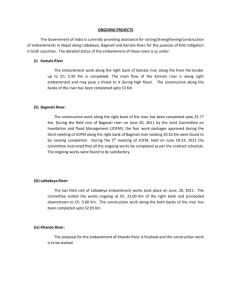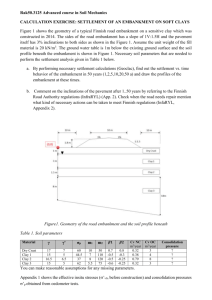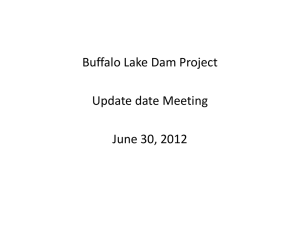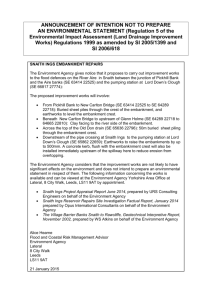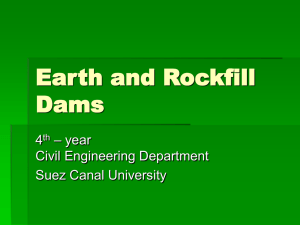Thermal response of air convection embankments to ambient
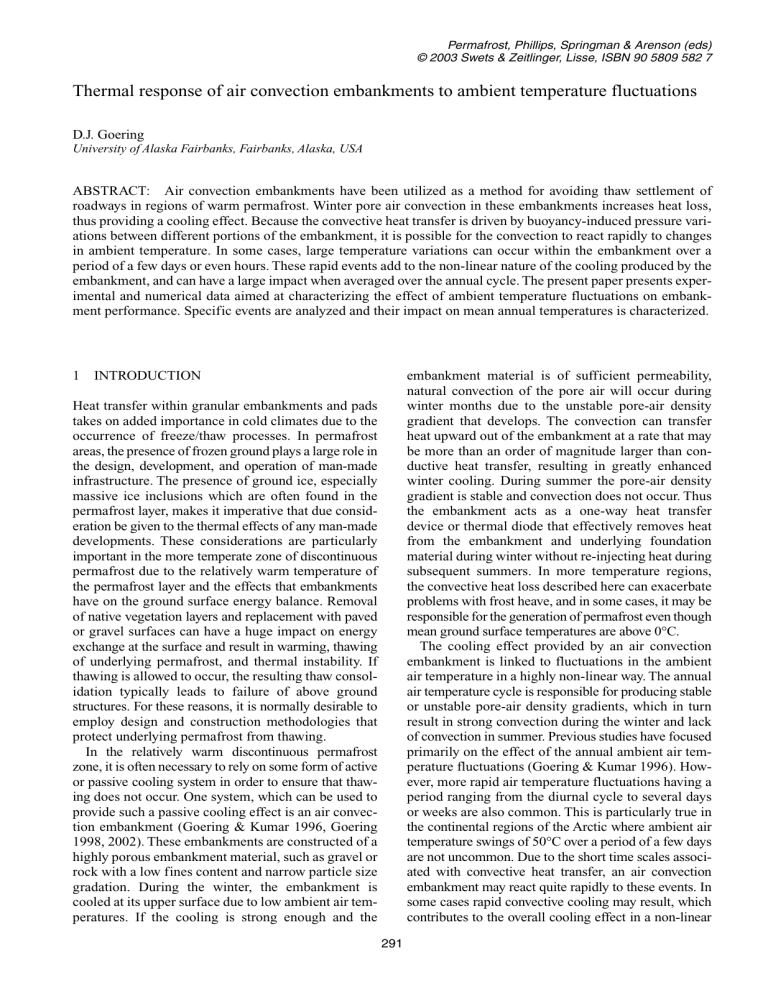
Permafrost, Phillips, Springman & Arenson (eds)
© 2003 Swets & Zeitlinger, Lisse, ISBN 90 5809 582 7
Thermal response of air convection embankments to ambient temperature fluctuations
D.J. Goering
University of Alaska Fairbanks, Fairbanks, Alaska, USA
ABSTRACT: Air convection embankments have been utilized as a method for avoiding thaw settlement of roadways in regions of warm permafrost. Winter pore air convection in these embankments increases heat loss, thus providing a cooling effect. Because the convective heat transfer is driven by buoyancy-induced pressure variations between different portions of the embankment, it is possible for the convection to react rapidly to changes in ambient temperature. In some cases, large temperature variations can occur within the embankment over a period of a few days or even hours. These rapid events add to the non-linear nature of the cooling produced by the embankment, and can have a large impact when averaged over the annual cycle. The present paper presents experimental and numerical data aimed at characterizing the effect of ambient temperature fluctuations on embankment performance. Specific events are analyzed and their impact on mean annual temperatures is characterized.
1 INTRODUCTION
Heat transfer within granular embankments and pads takes on added importance in cold climates due to the occurrence of freeze/thaw processes. In permafrost areas, the presence of frozen ground plays a large role in the design, development, and operation of man-made infrastructure. The presence of ground ice, especially massive ice inclusions which are often found in the permafrost layer, makes it imperative that due consideration be given to the thermal effects of any man-made developments. These considerations are particularly important in the more temperate zone of discontinuous permafrost due to the relatively warm temperature of the permafrost layer and the effects that embankments have on the ground surface energy balance. Removal of native vegetation layers and replacement with paved or gravel surfaces can have a huge impact on energy exchange at the surface and result in warming, thawing of underlying permafrost, and thermal instability. If thawing is allowed to occur, the resulting thaw consolidation typically leads to failure of above ground structures. For these reasons, it is normally desirable to employ design and construction methodologies that protect underlying permafrost from thawing.
In the relatively warm discontinuous permafrost zone, it is often necessary to rely on some form of active or passive cooling system in order to ensure that thawing does not occur. One system, which can be used to provide such a passive cooling effect is an air convection embankment (Goering & Kumar 1996, Goering
1998, 2002). These embankments are constructed of a highly porous embankment material, such as gravel or rock with a low fines content and narrow particle size gradation. During the winter, the embankment is cooled at its upper surface due to low ambient air temperatures. If the cooling is strong enough and the
291 embankment material is of sufficient permeability, natural convection of the pore air will occur during winter months due to the unstable pore-air density gradient that develops. The convection can transfer heat upward out of the embankment at a rate that may be more than an order of magnitude larger than conductive heat transfer, resulting in greatly enhanced winter cooling. During summer the pore-air density gradient is stable and convection does not occur. Thus the embankment acts as a one-way heat transfer device or thermal diode that effectively removes heat from the embankment and underlying foundation material during winter without re-injecting heat during subsequent summers. In more temperature regions, the convective heat loss described here can exacerbate problems with frost heave, and in some cases, it may be responsible for the generation of permafrost even though mean ground surface temperatures are above 0°C.
The cooling effect provided by an air convection embankment is linked to fluctuations in the ambient air temperature in a highly non-linear way. The annual air temperature cycle is responsible for producing stable or unstable pore-air density gradients, which in turn result in strong convection during the winter and lack of convection in summer. Previous studies have focused primarily on the effect of the annual ambient air temperature fluctuations (Goering & Kumar 1996). However, more rapid air temperature fluctuations having a period ranging from the diurnal cycle to several days or weeks are also common. This is particularly true in the continental regions of the Arctic where ambient air temperature swings of 50°C over a period of a few days are not uncommon. Due to the short time scales associated with convective heat transfer, an air convection embankment may react quite rapidly to these events. In some cases rapid convective cooling may result, which contributes to the overall cooling effect in a non-linear
way, essentially ratcheting down the temperature of the embankment material at each occurrence.
In the present work, the effect of rapid ambient air temperature fluctuations and rapid convection events is examined. Both experimental and numerical data is utilized to study the behavior of an air convection embankment under conditions of high frequency (days to weeks) air temperature fluctuations. The results show that these events do have an impact on overall embankment performance, tending to increase the cooling effectiveness of the system.
and a single thermistor was installed in a radiation shield and used to measure ambient air temperatures at the site. A data acquisition system was used to collect hourly temperature readings automatically.
Due to cost constraints, it was not possible to pave the test embankment, however, a plastic covering was used on the upper surfaces of the embankment to imitate the presence of an impermeable layer of asphalt or top soil. During early winter a small layer of snow was compacted into an ice sheet on the upper surface of the embankment in order to simulate the presence of an asphalt covering. After approximately 10 cm of compressed snow had accumulated, any additional snow fall was plowed off the driving surface onto the embankment side slopes using conventional road plowing equipment.
2 EXPERIMENTAL STUDIES
2.1
Experimental embankment installation
During recent years, two experimental projects have been carried out with the aim of characterizing the thermal behavior of air convection embankments. In 1993 an experimental test embankment was constructed at
Brown’s Hill Quarry near Fairbanks, Alaska and monitored for a period of two years (Goering 1998). In addition, the Alaska Department of Transportation constructed a second test embankment through the
Experimental Features in Construction Program near
Fairbanks, Alaska (Goering 1997), which has subsequently been monitored continuously. These test embankments are both in located in the discontinuous permafrost zone of interior Alaska.
Experimental data collected from the Brown’s
Hill test embankment have been discussed elsewhere
(Goering 1996, 1998). The embankment was constructed of crushed rock in the size range of 5–7.5 cm.
It had a height of 2.5 m and a width of 5 m at the top driving surface with 2H:1V side slopes. Figure 1 shows a cross section of the test embankment indicating the basic dimensions and positioning of temperature sensors. 44 thermistor temperature sensors located in
4 separate horizontal thermistor strings were installed within the cross section. The sensors are located in a grid array with dimensions 60 60 cm starting at the original ground elevation and extending upward into the embankment. In addition, four thermistors were installed vertically beneath the embankment centerline
2.5 m
5 m
3 m
Driving Surface
Thermistor Locations
C
L
Figure 1.
Experimental embankment configuration showing thermistor positions.
292
2.2
Experimental results – thermal offset
Figure 2 shows a record of temperature data taken during the second winter of operation of the Brown’s Hill test embankment. In order to get and indication of the cooling effectiveness and dynamic characteristics of the thermal response, four mean daily temperature time series have been plotted. These include the record of ambient air temperatures at the site as well as three other temperature series, which were generated based on the measurements taken within the embankment.
The series labeled “Average Upper” represents the mean value of the uppermost 11 thermistors, all of which are located at a depth of about 60 cm beneath the upper surface of the embankment. The series labeled
“Average Base” represents an average of the thermistors in the bottom string, which are located adjacent to the original ground surface at the base of the embankment. Finally, the series labeled “Offset” simply represents the difference between the “Average Upper” and
“Average Base” values.
The offset can be thought of as a measure of the effectiveness of the convective heat transfer. A large convective component produces significant mixing within the embankment and, therefore, results in a more uniform temperature profile from top to bottom.
Thus, active convection is indicated by a small offset.
On the other hand, when convection is inactive, the inefficiency of conductive heat transport allows a large vertical temperature gradient to become established in the embankment and the offset value increases.
Examining the results presented in Figure 2, indicates that during summer the offset tends to follow the trends of the “Average Upper” data with a comparatively large positive value. At the same time, the “Average
Upper” and “Average Base” data series are not closely coupled. During winter, on the other hand, the offset remains slightly negative although close to zero, and
30
20
10
0
-10
-20
-30
-40
Ambient Air
Average Upper
Average Base
Offset
-50
A S O N D J
Time (month)
F M A M J
Figure 2.
Temperature series taken from the Brown’s Hill test embankment during the second winter of operation (1994–1995).
the “Average Upper” and “Average Base” track very closely together. This behavior is generally illustrative of the effectiveness of the convective heat transfer mode, which “turns on” whenever the upper temperature attempts to decrease much below the base temperature. Close examination of the behavior of the “Offset” data series shows that it is correlated with extreme events in the air temperature series. Following periods of low ambient air temperature (during winter) the offset tends to approach zero from a mildly negative value.
Another indication of the non-linear effect of the convection cooling mechanism can be seen by comparing the mean annual temperatures of the four thermistor strings shown in Figure 1. Averaged over the same time period as shown in Figure 2, these four values are 1.99, 0.68, 1.06, and 1.84°C, arranged from top to bottom within the embankment. Thus, there is a reduction of almost 4°C in mean annual temperature between the upper and lower thermistor strings, illustrating a substantial passive cooling effect.
-20
-25
-30
-35
0
-5
-10
-15
-40
-45
-50
11/15 11/25 12/5 12/15
Date
Figure 3.
Mean daily ambient air temperature at the test embankment site 11/15/94–12/15/95.
2.3
Experimental results – temperature profiles
Ambient air temperature data displays significant air temperature fluctuations (Fig. 2). These are particularly pronounced during the winter season. The majority of these variations have a period of approximately one week and amplitudes varying from 10 to 30°C. In order to examine the detailed effects that these fluctuations had on the test embankment, a segment of the time period has been extracted for further examination.
The selected period extends from November 15 to
December 15 and incorporates three large temperature swings ranging from about 5 to 45°C. The air temperature data has been extracted and re-plotted in
293
Figure 3, which shows individual data markers for each day in the sequence.
As shown in Figure 3, the period between 11/15 and
12/15 contained a nearly harmonic ambient temperature fluctuation of 2.5 cycles in length. The cycles begin on 11/18 and end on about 12/8, having a total duration of 20 days and a period of about 8 days. During this time, ambient temperature fluctuates between 15°C and 45°C. Corresponding embankment temperature isotherm plots are shown in Figure 4 for several days during this cycle. The isotherms shown in the figure cover the portion of the embankment that has been instrumented with the thermistor grid (Fig. 1). The data were collected at noon on the day indicated in each of the plots.
Figure 4.
Temperature isotherm plots in the Brown’s Hill test embankment during the 11/15–12/15 time period. Exact dates indicated in the figures.
The sequence shown in Figure 4 begins on 11/16 with a pattern of relatively warm uniform temperature profiles in the embankment. Temperatures range from about 1 to 4°C and there is little indication of convective circulation. Between 11/16 and 11/21, ambient temperature drops about 20 to 25°C and the iso-therm patterns in the embankment begin to change in reaction to the cooling. Further reduction of the ambient temperature occurs between 11/21 and
11/23, reaching about 44°C on the 23rd. The pattern of isotherm shapes shown in the first three plots of
294
Figure 4 shows that the embankment temperature profiles react rapidly to the reduction in ambient temperatures. The images shown for 11/16, 11/23, and 11/25 display the development of a pronounced plume structure within the cross section as convective activity ensues. Convective flow occurs in a cellular structure with pore air alternately circulating upward and downward within the embankment. By 11/25 the convective plumes are affecting temperatures all the way down to the base of the embankment, producing rapid cooling at the base. By 11/27 temperatures have cooled
to approximately 3 to 4°C at the base, a reduction of about 2°C over the course of a few days. Between
11/23 and 11/27 the ambient temperature rises from
44°C back up to about 22°C. A few days later, on the 29th, the intensity of the convection and associated plumes decreases somewhat in reaction to the warming.
Between 11/27 and 11/30 the second pronounced cooling trend occurs and the plumes within the embankment again intensify. The intense convection lingers until about the 1st of December, lagging the warming trend, which starts on 11/29. After 12/1, the convection intensity again decreases as the warming trend between 11/29 and 12/2 begins to affect the embankment with the plumes essentially disappearing entirely by 12/5. A final cycle of cooling and warming occurs between 12/2 and 12/8. Again the embankment convection reacts after a time lag of a few days and intense convection plumes again appear in the embankment isotherms on 12/7. Finally, by 12/13 the convection slows down due to the warming ambient air and the plumes dissipate.
The net result of the convective activity described above was a cooling at the base of the embankment of about 4°C during the time period considered. It is clear from the sequence of plots shown in Figure 4 that the embankment reacts to ambient air temperature changes rapidly with a time lag of a few days. In some cases large changes are observed in the embankment temperature profiles on a day-to-day basis, although more detailed examination of the hourly data revealed minimal changes on an hourly time scale. The rapid dynamic response contributes to cooling at the embankment base in a non-linear way, tending to suggest that rapid air temperature fluctuations must be considered when attempting to characterize the cooling capacity of air convection embankment structures.
3 NUMERICAL STUDIES
In order to characterize the impact of ambient air temperature fluctuations in a more systematic way, a series of numerical simulations were carried out.
Numerical solutions were obtained via a twodimensional unsteady finite element model as described in Goering & Kumar (1996). The model uses linear triangular finite elements and is capable of solving two-dimensional unsteady heat transfer problems in geotechnical materials such as soil, sand and gravel. The numerical simulation produces a time history of temperature and pore air velocity throughout the grid as the boundary conditions vary on an annual cycle. The model was tested to ensure accuracy. See
Goering & Kumar (1996) for details regarding the governing equations, numerical method and validation studies.
295
A set of four numerical simulations were carried out using material properties and numerical grid size identical to that employed in Goering & Kumar
(1996). Thermal boundary conditions were also identical with the exception that a rapid temperature fluctuation (described below) was superimposed on the baseline annual air temperature function. The baseline function consisted of a harmonic temperature variation with a period of one year and an amplitude and mean that are adjusted based on the characteristics of the surface type, see Goering & Kumar (1996) for details. The resulting thermal boundary conditions have mean annual temperature values of 1.1, 2.7, and
1.9°C on the upper driving surface, embankment side slope, and native ground surface, respectively.
The first of the four simulations was, in fact, identical to that presented in the earlier study and was used as a base for comparison. The resulting mean annual temperature profiles are shown in Figure 5a for the right half of the embankment and a portion of the foundation soil (the modeling procedure assumed symmetry about the centerline). These profiles show a zone of relatively low temperatures beneath the center of the driving lane where there is a region with mean annual temperatures lower than 4°C. This is true despite the fact that the mean embankment surface temperatures are well above the freezing point. The temperature depression is a result of the non-linear convective effect.
Note that the mean annual temperatures shown in the figure are in approximate agreement with the mean values of 1.99, 0.68, 1.06, and 1.84°C (arranged top to bottom) that were calculated for the four horizontal thermistor strings described in section 2.2.
The next three simulations were all modified from the base case by the addition of a temperature fluctuation on top of the base function. In each case a temperature fluctuation with an amplitude of 7.5°C
(15°C peak to peak) and a period of one day, one week, or one month, was utilized. The value of 7.5°C was arrived at by examination of the ambient air temperature fluctuations shown in Figure 2. In each case the fluctuation was applied evenly throughout the year and the simulations were run for several years to ensure that initial transients had died out. For the case with a fluctuation period of one day a numerical time step size of 0.1 day was utilized, while for the one week and one month period a time step of 0.25 day was used.
Figure 5b shows the results for the base case plus a one day temperature fluctuation. Comparing these profiles to those shown in Figure 5a reveals a slight cooling near the embankment surface and a slight warming in the lower portions of the embankment. All-in-all, however, the differences between the base case and the one day fluctuation are minor. This is most likely to be a result of the fact that fluctuations with a period of
additional cooling over and above that produced by the base case analysis. This is a result of the additional convective activity induced by the superimposed weekly fluctuations.
Finally, Figure 5d shows the results for the base case plus a fluctuation with a one month period. Again, an enhanced cooling over that produced by the base case is evident. Based on the results shown in Figure 5, it appears that the rapid temperature fluctuations do produce additional enhancement of the non-linear convection cooling effect. They also show that fluctuations with a longer period tend to be more effective at reducing mean annual temperature values.
4 CONCLUSIONS
Experimental and numerical results have been examined with the aim of characterizing the dynamic response of air convection embankments to rapid fluctuations in ambient air temperatures. The experimental data shows that the embankment can react rapidly to air temperature variations with a rapid appearance and disappearance of thermal plumes in the embankment cross section. These plumes have a cooling influence on the embankment structure and tend to promote low base temperatures by rapidly transporting chilled air from the top to the bottom of the embankment. The numerical results show that a systematic fluctuation superimposed on the base annual temperature variation will produce modest reductions in the mean annual temperatures within the embankment. Fluctuations with a period of one month were more effective than those with a period of one week and daily fluctuations had an effect that was nearly negligible.
Figure 5.
Mean annual temperature profiles: numerical model, superimposed temperature fluctuation of 7.5°C. a) No fluctuation b) Period 1 day c) Period 1 week d) Period 1 month.
1 day are too rapid to produce a large thermal response within the embankment.
Figure 5c shows the results for the base case plus a temperature fluctuation with a one week period. This situation is similar to the experimental data that was examined in section 2.3. This time the results show
REFERENCES
Goering, D.J. & Kumar, P. 1996. Winter-time Convection in
Open-Graded Embankments. Cold Regions Science and Technology 24: 57–74.
Goering, D.J. 1997. Air Convection Embankment Experimental Feature Design Phase I. AKDOT&PF Technical
Report #AK–RD–97–02, Fairbanks, AK.
Goering, D.J. 1998. Experimental Investigation of Air
Convection Embankments for Permafrost-Resistant
Roadway Design. In Proceedings, 7th International
Conference on Permafrost, Yellowknife, NWT :
319–326.
Goering, D.J. 2002. Convective Cooling in Open Rock
Embankments. In Proceedings, 11th International
Conference on Cold Regions Engineering, Anchorage,
AK : 629–644.
296
